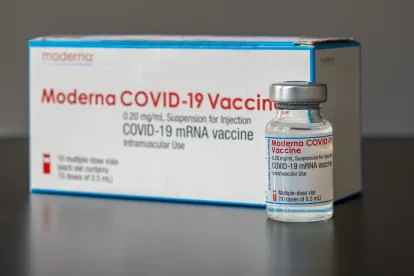Holding: In ModernaTx, Inc. v. Arbutus Biopharma Corp., --F.4th__, 2021 U.S. App. LEXIS 35471, 2021 WL 5617751 (Fed. Cir. Dec. 1, 2021), the Federal Circuit dismissed Moderna’s appeal for lack of standing.
Background
Arbutus, formerly known as Protiva, owns U.S. Pat. No. 9,364,435 (“the ’435 patent”) directed to “stable nucleic acid-lipid particles (SNALP) comprising a nucleic acid (such as one or more interfering RNA), methods of making the SNALP, and methods of delivering and/or administering the SNALP.” Protiva licensed the ’435 patent to Acuitas Biotherapeutics (“Acuitas”) and Acuitas granted Moderna a sublicense that allowed Moderna to practice the patented technology with four viral targets, including Respiratory Syncytial Virus (“RSV”) under the ’435 patent.
Moderna petitioned the Patent Trial and Appeal Board (“the Board”) for inter partes review (“IPR”) of all claims in the ’435 patent. The Board found (1) that Moderna proved by a preponderance of the evidence that Claims 1–6, 9, 12, and 14–15 are anticipated, but (2) Moderna failed to prove that the remaining claims are anticipated, or that those claims would have been obvious over the prior art. See Moderna Therapeutics, Inc. v. Protiva Biotherapeutics, Inc., IPR2018-00739, Paper 51 (P.T.A.B. Sept. 11, 2019).
The Board’s IPR Final Written Decision issued Sept. 11, 2019. Moderna filed its appeal in November 2019. Protiva quickly moved to dismiss for lack of standing on the ground that Moderna had not established an injury in fact, since the IPR was the only proceeding between the parties and there was no related patent infringement litigation.
Moderna argued that the required injury-in-fact for standing was based on the sublicense it held to the ’435 patent, which was impacted by the Board’s patentability determination. Moderna argued that “the royalty and milestone obligations it owed to Acuitas for the use of ’435 patent’s caused harm to Moderna” by increasing its financial burdens to develop RSV vaccines. ModernaTx, at *12. Moderna relied on Samsung Electronics Co. v. Infobridge Pte. Ltd., 929 F.3d 1363, 1368 (Fed. Cir. 2019) to support its position that financial impacts to an appellant based on licensing obligations “can be an independent means by which to establish an injury-in-fact supporting standing.” ModernaTx, at *11.
The Court denied Protiva’s motion to dismiss without prejudice noting that Protiva could raise its standing argument in its merits brief. In that brief, Protiva argued that the “mere existence of a license” is insufficient to establish standing and noted that Moderna had not made milestone payments under the license since February 2016. Id. at *13. Moreover, Protiva argued that Moderna had not shown how its payment obligations would change if the ’435 patent was held unpatentable. Id. at *16.
In March 2021, Moderna filed a motion to supplement the record to provide additional evidence of standing. Moderna explained that “new facts supporting Moderna’s ongoing standing to appeal have arisen, and the existing facts have continued to develop.” Id. at *14 (quoting Moderna Mot. to Suppl. at 3). The motion was supported by a supplemental declaration executed by Moderna’s Senior Vice President and Deputy General Counsel that “Moderna had, at some point during the previous year, terminated the RSV development program that had been active at the time that the appeal was filed. He also admitted that none of the four viral targets that were covered under the Acuitas sublicenses were being pursued to further phases, though he noted that they had not been fully abandoned.” Id. The “new facts” related to Moderna’s ongoing development of a vaccine for COVID-19 and the increased risk that Arbutus would sue for patent infringement given its refusal to grant Moderna a covenant not to sue. Id. at *14-15. According to Moderna, the license provided the basis for standing when the appeal was filed, and the development of the COVID vaccine “keeps the controversy alive.” Id. at *14-16.
Federal Circuit Decision
Before considering the merits of Moderna’s arguments on appeal, the Federal Circuit set out to determine whether Moderna had standing. Precedent since post-grant proceedings came into effect under the America Invents Act (“AIA”) has established that an appellant seeking review of a Board decision in an IPR must have “(1) suffered an injury in fact, (2) that is fairly traceable to the challenged conduct of the [appellee], [and] (3) that is likely to be redressed by a favorable judicial decision.” Id. at *9, citing Phigenix Inc. v. Immunogen, Inc., 845 F.3d 1168, 1171–72 (Fed. Cir. 2017) (quoting Spokeo, Inc. v. Robbins, 136 S. Ct. 1540, 1547 (2016)). The Court explained that participation in the underlying IPR “is insufficient by itself to confer standing on that party to appeal the Board’s decision to this Article III court.” Id. Thus, Moderna bore the burden to establish that it suffered the requisite injury and that standing existed not only at the time it filed its appeal but also that it continued throughout the appeal. Id. at *10.
The Federal Circuit agreed with Arbutus that Moderna lacked standing at the time it filed its appeal. Id. at *17. The Court explained that Moderna’s evidence of financial burdens from the validity of the ’435 patent were too speculative, causing Moderna to “fall[] short of its burden” to demonstrate an injury at the time it filed the appeal. Id. Although Moderna relied on Samsung, the Court found the facts of this case aligned more with Apple Inc. v. Qualcomm Inc., 992 F.3d 1378 (Fed. Cir. 2021), where despite licensing multiple patents, appellant lacked standing because they failed to present evidence that finding the patents unpatentable would affect its royalty obligations under the contract. Id. at *18-19.
The Federal Circuit also determined that Moderna failed to demonstrate that it had standing throughout the pendency of the appeal. Specifically, Moderna failed to show (1) when the RSV development program ended, and (2) whether development of the COVID-19 vaccine was underway when that program ended. Id. at *19-20. “Under our precedent, an ‘intervening abandonment of the controversy produces loss of jurisdiction.’” Id. at *19, citing Momenta Pharms., Inc. v. Bristol-Myers Squibb Co., 915 F.3d 764, 770 (Fed. Cir. 2019).
Ultimately, Moderna failed to meet its burden in establishing its standing to pursue an appeal, and its appeal was dismissed. Id. at *20.
With respect to Arbutus’ cross appeal, the Court affirmed the Board’s Final Written Decision holding Claims 1-6, 9, 12, and 14-15 unpatentable.
Takeaways
-
A party’s participation in an IPR is insufficient by itself to confer standing on that party to appeal the Board’s decision to an Article III court. The appellant must show standing existed at the time it filed its appeal and continued to exist at all times throughout the appeal.
-
Financial impacts to an appellant based on licensing obligations can be an independent means by which to establish an injury-in-fact supporting standing. In Samsung, the appellant provided evidence demonstrating that, based on the express terms of the contract, cancellation of the claims at issue in the underlying IPR would have changed the amount of royalties.
-
Clear evidence on the record is important to show that a party continuously had standing throughout the pendency of the appeal. An “intervening abandonment of the controversy produces loss of jurisdiction.” Momenta Pharm., Inc. v. Bristol-Myers Squibb Co., 915 F.3d 764, 770 (Fed. Cir. 2019).




 />i
/>i

